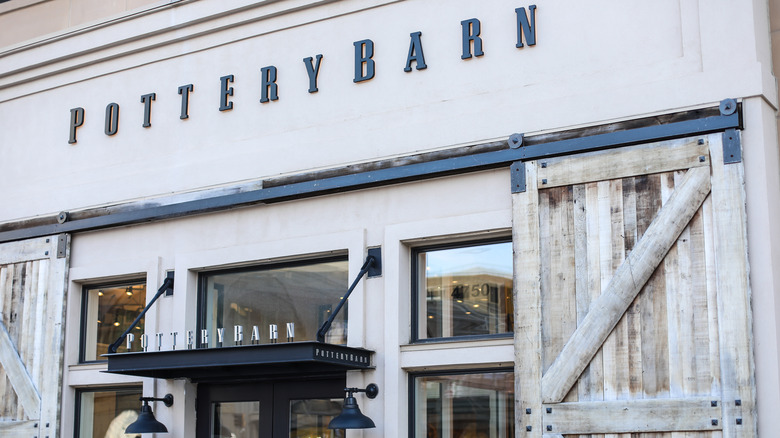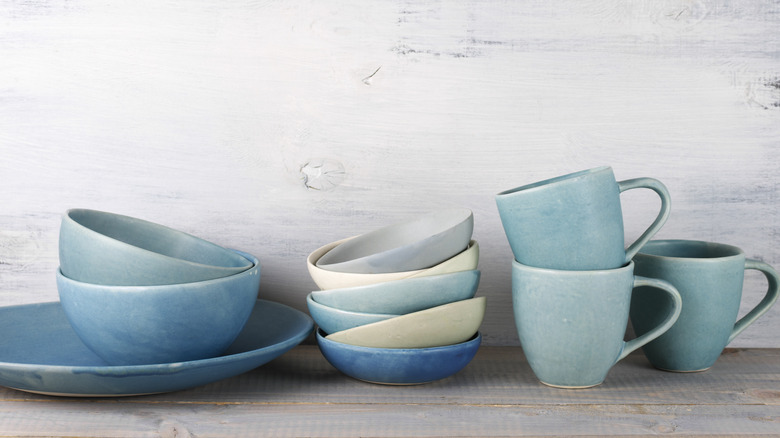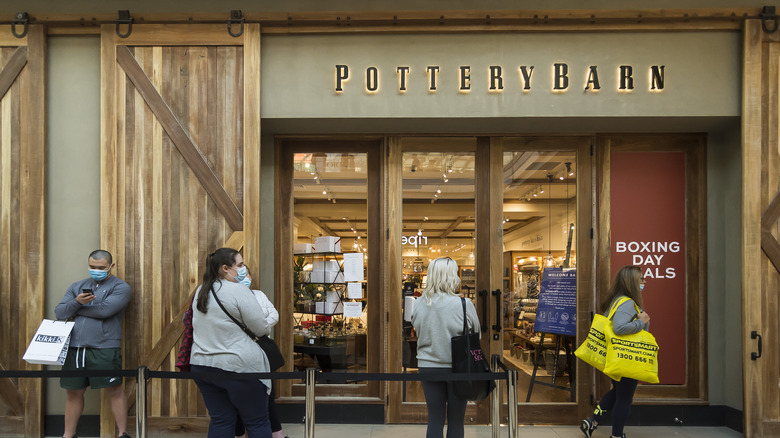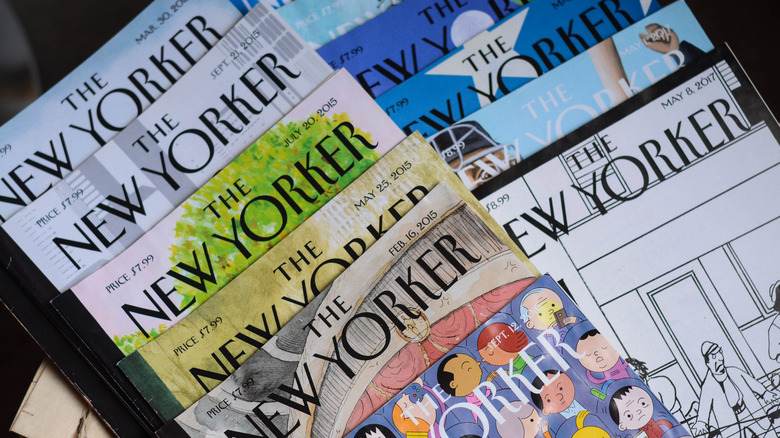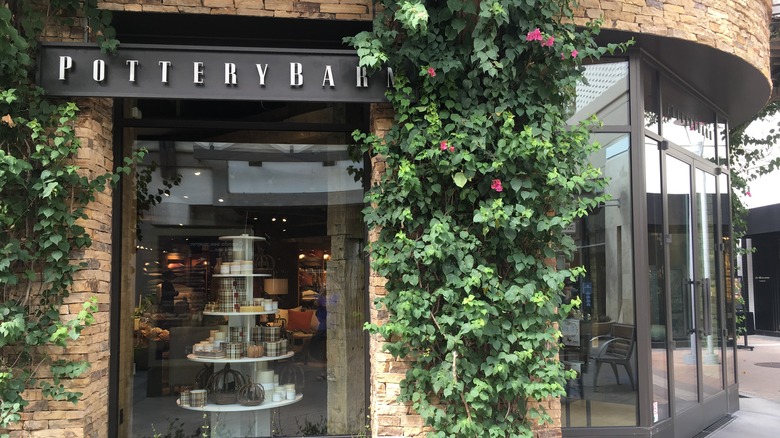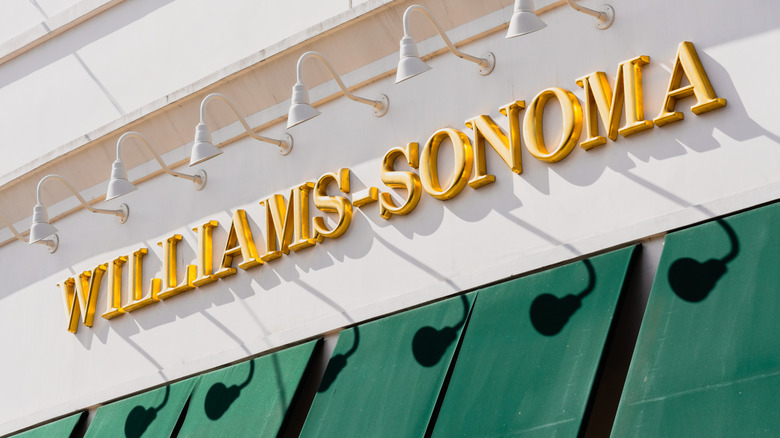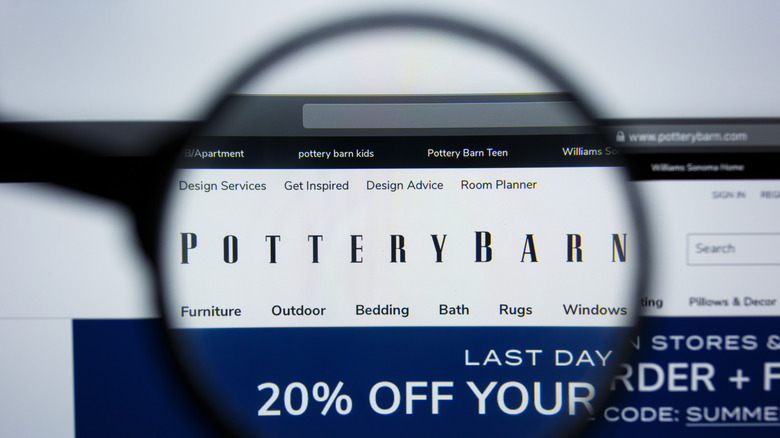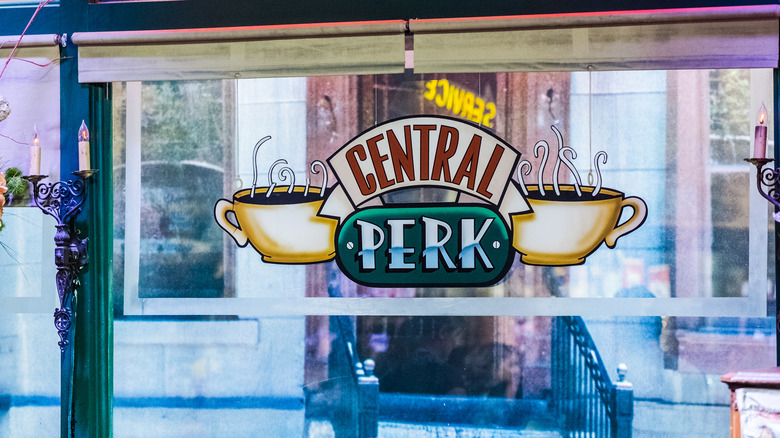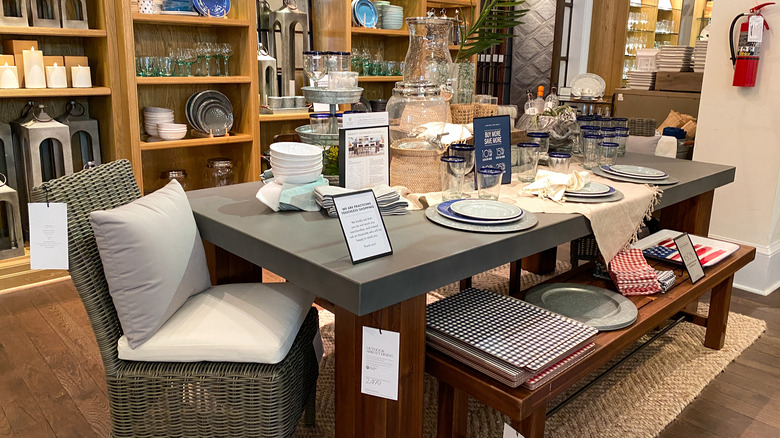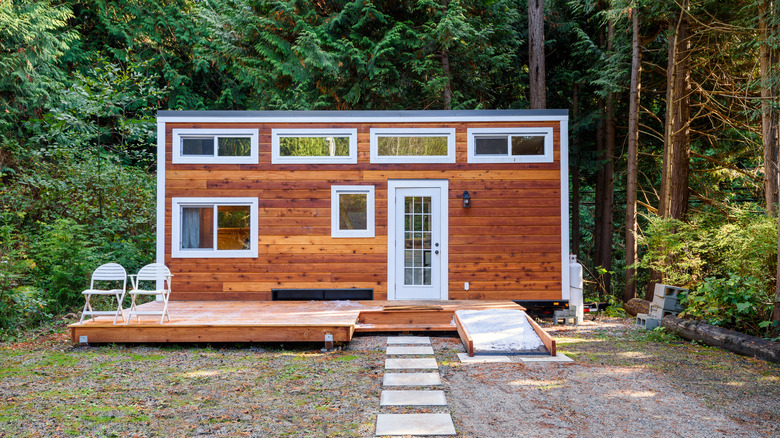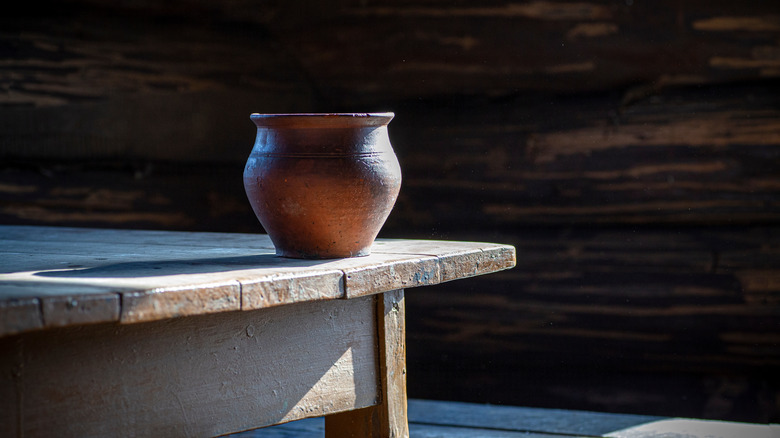The Untold Truth Of Pottery Barn
When you reflect on timeless name brands we've come to know and trust, what are some of the big wigs that come to mind? You might picture the obvious, like Ford or Coca-Cola, which are both examples of ultra-successful companies that meet the ebb and flow of customer demands and are still flourishing today. Would you believe us if we said Pottery Barn is on the same list? From humble beginnings in 1940s New York to its future success as an international company, it is a true rags-to-riches tale. But the brand is so successful because it constantly keeps the consumer in mind.
"I ask my designers, 'Will you take it home or give it as a present to your best friend?'" CeliaTejada, Pottery Barn's senior vice president for design and product development, told Fast Company. "If they hesitate, I say, 'Throw it in the garbage. Don't even bother.' Emotionally, it has to feel right." That's why shoppers are only introduced to the softest, most timeless, and most aesthetically pleasing decor and home pieces on the market. But there's more to the store than just fluffy white towels and classic table runners. Here is the untold truth of Pottery Barn.
Pottery Barn is nearly a century old
In 1950, only 17 years after the Great Depression, when other soon-to-be-national brands like Circuit City and Cutco opened their first retail stores, Pottery Barn was born in Manhattan, New York. As shared in an interview with The New York Sun, brothers Paul and Morris Secon launched their store in Manhattan, where they first sold decorative pottery and then European furniture. They rooted their humble pottery business in a series of four brick-and-mortar storefronts by 1963 — two Manhattan locations, plus, a store in Philadelphia and Boston.
When the business had expanded to seven branches, Paul moved forward with his savvy idea to produce and publish the first Pottery Barn catalog (via EmilMilan). It was Paul's way of delivering designer products for less. After decades of dedication to Pottery Barn, the brothers sold their small business to two multi-million-dollar companies by the mid-1980s. Fast forward decades later, Pottery Barn celebrated its 73rd birthday in 2022.
The company's name says it all
According to The New York Times, in 1949, the two brothers discovered three rural barns stocked with secondhand pottery from Glidden Parker, a popular 1950s stoneware company that discontinued the pieces and went out of business shortly after. Paul and Morris struck retail gold, and they knew it; at least enough to make a modest beginning and pay the bills. Their bright idea? Resell the hand-me-down pottery as is, some of it slightly damaged and imperfect, exposing an unrealized demand for affordable, and apparently charming, secondhand goods.
The duo kept the name simple and honest, like their business plan — Pottery Barn. It began just as they had imagined: modest in business model and presentation (via The New York Sun). Though the name is still the same today (and bigger than the brothers could've ever dreamt), Pottery Barn is known for carrying modern, quality furniture and home decor for the entire home and family.
Both founders were expert musicians
The future Pottery Barn pioneers were born in Philadelphia to Russian-immigrant parents, who owned a local, successful bakery and encouraged musicality in their sons. This led to the brothers' notable musical accomplishments. Morris Secon, born in 1923, started playing the trumpet at 10 years old, having watched his cousin. Three years later, Secon switched to the horn and never looked back. He learned from horn greats, like Arthur Geithe, who also taught Morris Secon to sing, and would become an integral part of the Rochester Philharmonic.
The other Secon brother, Paul, born in 1916, showed interest in a number of instruments, including trumpet, piano, oboe, and flute (via The New York Sun). He eventually composed songs, including "My O'Darlin' My O'Lovely My O'Brien," sang and recorded by Rosemary Clooney. Paul also worked as a critic for the Boston Evening Transcript, and a reporter for Billboard, now famous for ranking hit songs on the Billboard Music Chart. He even had a son who wrote and performed his own rap song in 1995.
Pottery Barn was never supposed to be this big
According to The New York Times, when the first store opened in 1949 on 19th Street in Manhattan, Pottery Barn was only 12 feet wide and 110 feet long. The founders planned to make a modest living selling discontinued pottery, including plates, saucers, cups, and platters, but the company grew faster than imagined. After the shop took off, Paul Secon was inspired and expanded its offering to include discounted furniture designs straight from Europe, which attracted even more patrons.
After their initial success, the Secons could afford to move into a larger building not far from the original, and offer other goods at discounted prices, including authentic Danish ware and teak furniture. By 1966, the brothers ran multiple stores and one high-end outlet throughout New York, Philadelphia, and Boston. Their one-and-done plan quickly morphed into more than 70 years of retail success.
A local newspaper mention led to overnight success
Starting in the 1920s, The New Yorker headed a popular culture column called "On and Off the Avenue," still around today, highlighting popular trends and products. According to The New York Times, one morning in 1952, two years after the first Pottery Barn opened for business, The New Yorker published a short article on Manhattan's new small business. The reporter's description of the modest merchant— quality products though sometimes flawed —helped Pottery Barn become a local, overnight sensation.
The article spotlighted a small, brick-and-mortar store that may have never been discovered on a grand scale without the special mention. Even super-rich New-Yorkers, according to The New York Sun, arrived "in furs and jewels, lined up to take a whack" at the discontinued Glidden Park pottery. Eventually, the business would grow to include high-end housewares at wallet-friendly prices that even the socialites couldn't pass on. By the mid-1950s, the brothers opened a second location, and, come Christmas, customers had to be contained upstairs to avoid a "stampede" in the shop.
The brothers had to step away from Poverty Barn
The simple discovery of old, slightly damaged pottery, and the brilliant idea to bring in discounted international wares, kept the Secon brothers afloat for nearly 20 years. But by 1968, they decided to sell their respective shares in search of new, individual adventures revolving around their first love — music. The "Poverty" Barn, as older brother Morris Secon would eventually deem it, wasn't pulling in a fortune. "We were two kids playing store; we made a living," said Secon in a 2007 interview with The New York Times.
Eventually, Paul sold his shares to his older brother and moved out of the country to focus on his musical career (via The New York Sun). Morris Secon stayed with the business another year and quickly realized the logistic end of things (specifically, the chaos of accounting) wasn't where he was meant to flourish. He followed in his brother's footsteps and sold the rest of the business one year later to retailer Hoyt Chapin, who would grow the store to more than 10 branches over the next 15 years.
It's been acquired by ultra-famous brands
Before famous retailer Hoyt Chapin bought and expanded Pottery Barn to 13 stores, he had gained extensive retail experience working with mega companies like Bloomingdale's and Dansk earlier in his career, as per NH Business Review. His successful approach with Pottery Barn created enough hype and attention (and sales) that, come 1984, it was a worthy enough investment for America's worldwide clothing sensation The Gap (via The New York Times). It took the home-goods chain and ran with it, and more than doubled the number of new store locations in the U.S. within two years.
In 1986, Williams-Sonoma, still a giant in kitchen and home furnishings today (and owner of West Elm and Mark and Graham brands), purchased Pottery Barn. It turned it into the all-in-one home solution we know today, with 188 stores as of 2021 (via Pottery Barn). The company's ultimate goal was to grow market share within America's home-furnishing industry, and it did exactly that (via Home Stratosphere).
Pottery Barn made a vital cross-country move
Williams-Sonoma had a new goal — to grow market share in the home-furnishing industry, and it had a plan. With a strong, 30-year presence established on the East Coast, Pottery Barn headquarters moved from Manhattan to San Francisco, California, as per Home Stratosphere. The West Coast city is the home of William-Sonoma, according to its website, so the move made sense.
Fast-forward a few decades, and the brand was ready to capture bargain-hunters in California. Its first West Coast outlet store opened in August 2014 at the Southern California Tejon Ranch outlets, in a 12,400-square-foot space, selling Pottery Barn pieces for up to 70% off (via Racked). Today, these outlet locations are scattered all over the United States, including Arizona, Georgia, Illinois, Massachusetts, and Michigan. The brand now has nearly 20 outlets (and more than 150 official stores in 42 states) across the board.
The first Pottery Barn website launched in 2000
As instrumental web browsers like Yahoo! and Google started to gain popularity in the late '90s, Williams-Sonoma made the crucial decision to build and launch Pottery Barn's first webpage in August 2000, as per DMNews. In its infancy, the Pottery Barn site was dedicated to all things home, from new product designs and furniture to digital home tours and DIY help. The brand was on its way to becoming an end-to-end home-furnishing solution.
Upon launch, the website featured 2,000 products pulled from Pottery Barn's physical catalog, which the company believed best represented the newly branded business. Williams-Sonoma felt the decades-old retail store deserved its own dedicated site, as it featured a product portfolio unique to the popular West Coast kitchen conglomerate at the time (via Los Angeles Times). This helped carve out Pottery Barn's own brand and make it stand out more.
Pottery Barn was briefly a member of the 'Friends' cast
In the same year Williams-Sonoma launched the official Pottery Barn website, the brand starred in a Season 6 episode of 'Friends'. Specifically, in the episode titled "The One with the Apothecary Table," according to Vox. In it, Lisa Kudrow's eccentric, hippie-inspired character, Phoebe, is disgusted to discover a gorgeous apothecary table is not an antique, as promised by her roommate, but a mass-produced purchase from Pottery Barn.
That's not the only instance the rags-to-riches furnishing store took front and center on TV around the turn of the 21st century. In an episode of "Seinfeld" — "The Junk Mail" — Kramer (equally as eccentric as "Friends'" Phoebe) receives an endless supply of Pottery Barn catalogs in his mailbox, which he later dumps at the doorstep of a local Pottery Barn store. The long-time brand also starred in "The Big Bang Theory" and "Boy Meets World," and has partnered with other famous titles, like "Star Wars" and "Harry Potter" to release unique, film-inspired collections.
The brand is dedicated to reducing environmental waste
As an eco-conscious Williams-Sonoma company, Pottery Barn's modern-day motto touts "making an impact together," per its website. Today, the brand focuses on responsibly and ethically sourcing and creating products to help minimize the human footprint and restore natural resources. Each time you purchase a piece of indoor wood furniture, Pottery Barn promises to plant a tree to help reduce carbon footprint and aid in the growth and restoration of trees worldwide. The company is also committed to responsibly sourcing cotton by training thousands of farmers in sustainable methods, including water and energy savings.
According to Business Wire, shoppers can buy and return items confidently knowing Pottery Barn is the first major home-furnishing company to work alongside The Renewal Workshop, a forward-thinking entity dedicated to restoring damaged or excess products, so they don't end up in landfills. In recognition of its commitment to environmental excellence, the company continues to receive awards for "Most Sustainable" and acknowledgments as a leader in responsible sourcing.
Brick-and-mortar still pays (some of) the bills
As of 2017, Pottery Barn has nearly 200 stores in the U.S., Canada, Mexico, Australia, and the Philippines, as per Williams-Sonoma. Accelerated past efforts by Williams-Sonoma proved successful for the once-humble pottery chain, and brick-and-mortar stores still, surprisingly, make up half of its sales (via The Washington Post). Williams-Sonoma even turned some of its own physical stores into Pottery Barn locations as recent as 2021 — an impressive feat for the old-school business (via Times Union). But with the incredible rise in e-commerce across all industries, and with unstoppable forces like Amazon, the long-lived brand is forced to make constant adjustments to its business plan, including online availability and competitive pricing. That's because revenue from physical stores (for thousands of retail brands in all sects) is predicted to decline over time with incoming generations.
The good news is despite the ease and popularity of online shopping, many buyers still prefer the traditional shopping experience and depend on physical locations to touch and test merchandise, purchase items same-day, and encourage retailers to continue hiring humans over artificial intelligence (via The Balance Small Business).
The home-furnishing brand fights to remain relevant
The Washington Post reported that the only recession Pottery Barn experienced was during the Great Recession from 2007 to 2009. Now, the brand is working harder than ever to stay relevant as Millennials and Generation Z shift toward the digital shopping experience and current home trends take a turn toward minimalism. During its heyday, after Williams-Sonoma established its online presence, Pottery Barn offered full-size, mid- to high-end furniture and decor at reasonable prices, which kept the business booming during its transition into the digital era.
But recently, Williams-Sonoma has struggled to maintain a year-over-year increase in sales as tastes and trends transform to fit the needs of incoming generations. This includes inclusive pricing and compact designs, especially as housing and living costs (as seen in the U.S.) continue to skyrocket (via The BBC). To help curve the effects of inflation and generational gaps, Pottery Barn is dedicated to producing furniture and decor designed for smaller spaces, like apartments and tiny homes, and offering it online to remain relevant and continue improving sales, despite its old-school roots.
Pottery Barn said goodbye to one of its founders
Sixty years after American musician and entrepreneur Paul Secon and his brother Morris fatefully discovered those three barns in rural Alfred, New York, the duo lost an invaluable member. According to The New York Times, on February 24, 2007, Paul Secon died at 91 years old in his home in Rochester, leaving behind so much more than a humble pottery store. As a child prodigy, Secon spent his early years on whatever instruments he could find, quickly forming a deep love and natural talent for all things musical.
After Secon left Pottery Barn in 1966, he relocated to Denmark to pursue his lifelong music dream, which was put on hold after launching the successful home-goods chain. His musical prowess transitioned into composing songs for post-war artists, including the Nat King Cole Trio. Secon returned to the United States in the 1970s after he and his wife welcomed their son, Lucas Secon, who would follow in his father's musical footsteps. His son worked with modern-day icons, including Britney Spears, Christina Aguilera, Toni Braxton, and Mos Def.
